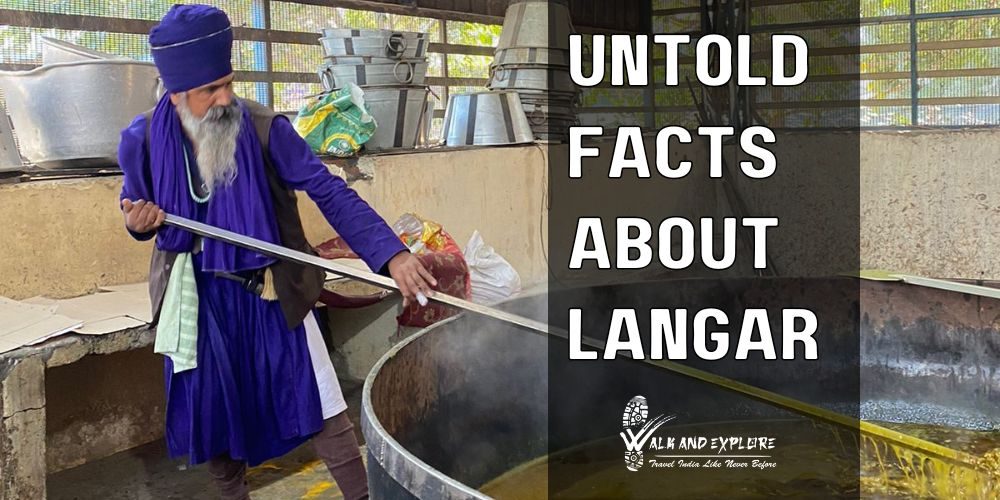Langar is a term used in Sikhism to refer to a ‘Community Kitchen’ or a free food service that is provided in Sikh Temples (gurudwaras). It is a central aspect of Sikh practices that emphasize principles of equality, community services, and sharing with others regardless of caste, creed, or social status of any individual.
Sikhism places great emphasis on the concept of seva, or selfless service to others. By volunteering to prepare and serve free food, Sikhs practice seva as a way of serving humanity and expressing their devotion to Waheguru. The tradition of langar was established by the founder of Sikhism, Guru Nanak Dev Ji, in the 15th century, and it continues to be an integral part of Sikh religious practice even today. The name “Guru ka Langar” signifies that the langar is not just a community kitchen but is directly associated with the teachings and practices of the Sikh Gurus.
If you also want to learn and experience of World’s largest community kitchen in person then book our Golden Temple Guided Tour.
Importance of Langar in Sikhism

Two of the key principles of Sikhism are ‘Equality’ and ‘Seva‘ for all regardless of their background, caste, creed, or social status. ‘Guru Ka Langar’ embodies both these important principles of the Sikh faith.
Through serving free food, Sikhs demonstrate their commitment to serving humanity and practicing seva as a fundamental aspect of their faith. It serves as a tangible expression of Sikh values, such as equality, humility, and generosity, while also providing practical assistance to those facing hunger or hardship.
The concept of a ‘free kitchen’ serves as a powerful tool for building and strengthening community bonds. When people come together to prepare, serve, and share food, they form connections and develop a sense of belonging and unity.
Also, it provides Sikhs an opportunity to engage in Seva by volunteering their time and resources to feed the hungry and serve the community. Participating in Langar allows them to cultivate qualities such as humility, compassion, and gratitude, and these qualities are central to Sikh teachings.
In short, Langar is not just a meal; it is a profound expression of Sikh values and a tangible embodiment of the principles of equality, community, and selfless service. Through Langar, Sikhs strive to create a more compassionate and just society we care and value for one and all.
How does the World’s largest community kitchen work?
Golden Temple in Amritsar runs the World’s Largest Community Kitchen. The langar service at the Golden Temple operates continuously throughout the day and night, providing free meals to anyone hungry.
Visitors can come here to eat whenever they want. There are no fixed meal timings as such because the langar service is available round the clock. Volunteers work in shifts to ensure that the langar service at Sri Harmandir Sahib never stops.
The Langar Hall is a large facility capable of seating thousands of people at once, ensuring that everyone who comes to the Golden Temple can enjoy a meal without any waiting time.
The langar at Golden Temple includes simple vegetarian food, including roti (flatbread), dal (lentil curry), sabzi (vegetable curry), and kheer (sweet rice pudding), among other dishes. Devotees are supposed to sit in ‘pangats’ endless rows to eat food. On average, approximately 20,000 eat Langar at Golden Temple daily, but on special occasions, there can be as many as 100,000 people.
Human Process to cook food

Cooking food at the langar in the Golden Temple involves a coordinated effort among volunteers who work selflessly to prepare and serve nutritious meals to thousands of people every day.
Rotis (flatbreads) are a staple of the langar meal. Volunteers roll out the dough and cook rotis on hot griddles called tawas. The dishes are prepared in huge cauldrons within the temple complex. Experienced volunteers oversee the preparation of various dishes to ensure that quality and hygiene standards are maintained.
Once the food is cooked, it is assembled and served in the world’s largest community kitchen. Volunteers work together to portion out the various dishes onto stainless steel plates or bowls, along with freshly cooked rotis. Visitors sit on the floor in rows, and volunteers circulate to serve the food.
After each meal service, volunteers engage in thorough cleaning and maintenance activities to ensure that the kitchen, dining area, and utensils are kept clean and hygienic. This includes washing dishes, sweeping floors, and sanitizing surfaces.
Machine Process to cook food

While the free food at the Golden Temple primarily relies on manual labor and traditional cooking methods, there have been efforts to introduce some level of automation and modernization to handle the large volume of food required. Automatic vegetable washers are used to clean large quantities of vegetables efficiently. Industrial-scale peelers and choppers are employed to chop vegetables such as potatoes, onions, and carrots. Also, automatic roti-making machines are used to produce rotis in large quantities.
How do they get funds?
The langar donation at Sri Harmandir Sahib is funded primarily through donations from Sikh devotees and visitors, as well as contributions from various Sikh organizations and philanthropists. We can make donations in the form of cash, food grains, cooking ingredients, etc. According to an estimate, the world’s largest community kitchenuses around 12,000 kilograms of flour, 15,000 kilograms of lentils, 1,500 kilograms of rice, and around 2,500 kilograms of vegetables each day.
How do they maintain hygiene?

Maintaining hygiene at the world’s largest community kitchen in the Golden Temple is a top priority to uphold the health and well-being of all who partake in the free meals. Volunteers undergo thorough hygiene training, ensuring they adhere to strict cleanliness practices, including regular handwashing and wearing clean attire. Only fresh, high-quality ingredients are used, and food handling procedures are meticulously followed to prevent contamination. Cooking temperatures are carefully monitored, and water quality is ensured. Additionally, proper waste disposal measures are in place, and hygiene inspections are conducted regularly to maintain sanitation standards.
How do volunteers handle thousands of visitors at Golden Temple?

Volunteers at the Golden Temple adeptly handle the immense influx of visitors with remarkable efficiency and dedication. They work in synchronized teams; each person is assigned a specific role and task. Signage and directional markers guide visitors through the sprawling complex, helping them navigate the various prayer halls, shrines, and langar halls efficiently. Security personnel and volunteers monitor entrances and exits to prevent overcrowding and ensure safety. Additionally, crowd control measures are implemented during peak times, such as religious festivals and holidays, to manage the influx of visitors.
How can you become a Volunteer?

Becoming a volunteer at the world’s largest community kitchen of the Golden Temple is a noble opportunity to serve others and participate in a centuries-old tradition of selfless service. Get in touch with other volunteers to express your interest in volunteering. Typically, volunteers are welcomed regardless of their background or religious affiliation, as langar is open to all.
How do you get to eat the langar at the world’s largest community kitchen?

To partake in the world’s largest community kitchen of the Golden Temple, visitors enter the hall and find a place to sit on the floor. Volunteers then serve them langar, consisting of dal, sabzi, roti, and sometimes rice or dessert. Once finished, visitors need to dispose of their plates and utensils in designated bins or areas. Volunteers then collect and clean the dishes to prepare for the next round of serving.
Menu at the world’s largest free kitchen in Golden Temple Amritsar

The langar menu at the Golden Temple in Amritsar offers a humble yet hearty spread of vegetarian dishes that nourish both body and soul. Visitors to the langar hall are greeted with the comforting aroma of dal, a lentil curry simmered with aromatic spices, alongside an array of vibrant sabzis, or vegetable curries. Freshly prepared rotis, hot off the griddle, accompany the main dishes, providing a wholesome base for the meal. Sweet kheer, a rice pudding delicately flavored with saffron and nuts, serves as a delightful finale to the feast.
You all know the Sikh principle of “Kirat Karni, Naam Japna, Vand Chhako.” This translates to “Earn an honest living, Meditate on God’s name, and Share with others.”
The principle of “Vand Chhako” or “Sharing with Others” lies at the heart of the langar tradition. It emphasizes the importance of selflessly sharing resources with those in need. Free food in Golden Temple serves as a tangible embodiment of this principle by providing free meals to all, irrespective of their socio-economic background. So, let us all embrace this principle and lead a balanced and virtuous life centered on honest work, spiritual devotion, and selfless service to humanity. Check out this amazing video by National Geographic India showcasing the workings of Langar and its making.
Book our Amritsar Full Day Guided Tour to learn more about Langar, Golden Temple and other important historical places in Amritsar and make your visit worth coming to Amritsar.


